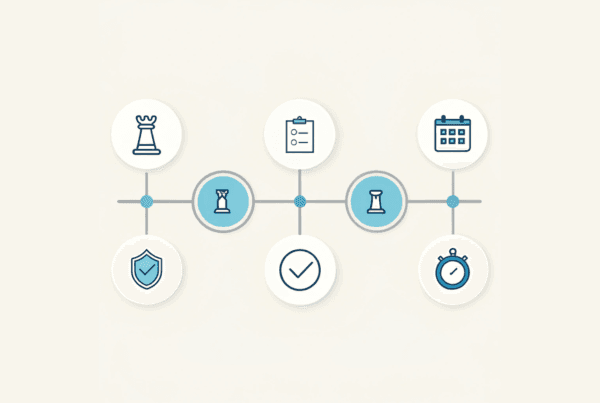
A comprehensive guide to understanding private equity transactions, deal structures, and processes for healthcare practice owners considering strategic partnerships or exits.
Table of Contents
- The Healthcare PE Revolution: Why This Matters Now
- What Makes Healthcare Private Equity Different
- The PE Transaction Process: From Interest to Closing
- Common PE Deal Structures in Healthcare
- The Roll-Up Strategy: Building Healthcare Platforms
- What to Expect: The First 100 Days After Acquisition
- PE vs. Hospital Acquisition: Understanding Your Options
- Preparing for PE Interest: A Practical Due Diligence Checklist
- Current Market Trends and Regulatory Outlook
- Making the Right Decision for Your Practice
The Healthcare PE Revolution: Why This Matters Now
If you’re a healthcare practice owner, you’ve likely heard whispers about private equity in the hallways of medical conferences or seen headlines about practice acquisitions in your specialty publications. Here’s a statistic that might surprise you: Private equity investment in healthcare has grown from $5 billion to over $100 billion between 2000 and 2018—a 2,000% increase that shows no signs of slowing.
But what does this mean for you as a practice owner? Whether you’re running a successful three-location dermatology group, managing a growing cardiology practice, or leading a multi-provider specialty clinic, understanding private equity has become essential strategic knowledge. You don’t need to be interested in selling tomorrow, but you should understand how PE partnerships work, what they offer, and how they might fit into your long-term vision.
The reality is that over half of PE-acquired practices undergo ownership changes within three years, with 97.8% being resold to other private equity firms. This isn’t necessarily negative—it often represents successful growth and value creation—but it underscores the dynamic nature of PE partnerships and why informed decision-making is crucial.
What Makes Healthcare Private Equity Different
Private equity in healthcare operates under unique constraints and opportunities that don’t exist in other sectors. Unlike acquiring a manufacturing company or software business, healthcare PE firms must navigate complex regulatory requirements, maintain clinical quality standards, and work within structures like Management Services Organizations (MSOs) to comply with Corporate Practice of Medicine laws.
The 2024 healthcare PE market reached an estimated $115 billion globally, representing the second-highest deal value total on record. This sustained investment reflects several attractive characteristics of healthcare practices:
- Recurring revenue models with established patient bases
- Limited correlation to economic cycles compared to discretionary services
- Aging demographics driving consistent demand growth
- Consolidation opportunities in fragmented specialty markets
- Technology integration potential for operational efficiency gains
Key Differences from Other Industries
Healthcare PE deals typically focus on EBITDA multiples ranging from 4-8x depending on practice size, specialty, and growth prospects. However, unlike other sectors, healthcare valuations must account for provider retention risk, regulatory compliance costs, and the inherent people-dependent nature of medical services.
The regulatory landscape creates both opportunities and constraints. Fifteen states now require transaction notifications for healthcare deals, and several others are proposing restrictive legislation. This evolving regulatory environment makes timing and structure increasingly important considerations.
The PE Transaction Process: From Interest to Closing
Understanding the PE transaction timeline helps set realistic expectations and prepare for each phase. The typical process spans 3-6 months from initial contact to closing, though preparation should begin much earlier.
Phase 1: Initial Engagement (Weeks 1-2)
The process begins when investment bankers send teasers to potential PE buyers—brief descriptions of your practice that maintain confidentiality while highlighting key financial and operational strengths. Interested parties then execute Non-Disclosure Agreements (NDAs) before receiving the comprehensive Confidential Information Memorandum (CIM).
Phase 2: Evaluation and Offers (Weeks 3-6)
PE firms conduct preliminary due diligence and submit Letters of Intent (LOI) outlining valuation ranges and key terms. This phase typically involves management presentations where you’ll discuss your practice’s capabilities, growth opportunities, and strategic vision.
Phase 3: Due Diligence (Weeks 7-14)
The most intensive phase involves comprehensive evaluation of finances, operations, legal compliance, and growth potential. PE firms utilize external advisors including attorneys, specialized accountants, and insurance experts to conduct thorough assessments.
Phase 4: Documentation and Closing (Weeks 15-20)
Final negotiations, definitive agreement drafting, and closing preparations. This phase includes working capital adjustments, final pricing confirmations, and transition planning.
| Phase | Duration | Key Activities | Your Involvement |
|---|---|---|---|
| Initial Engagement | 2 weeks | Teaser, NDA, CIM review | Moderate – information gathering |
| Evaluation & Offers | 4 weeks | Management presentations, LOI negotiations | High – active presentations and negotiations |
| Due Diligence | 8 weeks | Financial, legal, operational review | High – responding to information requests |
| Documentation | 4 weeks | Legal documentation, closing prep | Moderate – contract review and approvals |
For a detailed breakdown of each phase, see our comprehensive PE Transaction Timeline guide.
Common PE Deal Structures in Healthcare
Private equity firms employ several structural approaches to accommodate regulatory requirements and achieve investment objectives. Understanding these structures helps you evaluate which approach aligns with your goals and risk tolerance.
Leveraged Buyouts (Most Common)
Leveraged buyouts represent the most common PE deal structure in healthcare, where firms acquire controlling stakes using 60-70% debt financing. This structure allows PE firms to amplify returns while requiring practices to service debt obligations through cash flow generation.
Management Buyouts
These transactions allow existing practice leadership to partner with PE firms in acquiring the practice. Management buyouts often appeal to practices seeking to maintain physician control while accessing PE resources for expansion.
Growth Equity Investments
Minority investments that provide capital for expansion without requiring full practice sales. These structures commonly appear in specialty practices with proven scalability models, often preceding eventual full buyouts.
Seller Rollover Equity
A critical structural component allowing physicians to retain ownership stakes post-transaction. Rollover percentages typically range from 10-30% of practice value, creating potential for “second bite of the apple” returns upon eventual exit.
MSO Structures and CPOM Compliance
In states with Corporate Practice of Medicine restrictions, PE firms structure transactions through Management Services Organizations (MSOs) that provide administrative services while physicians retain medical decision-making control through professional corporations.
Learn more about MSO structures and how they work in our detailed MSO Structure Explained guide.
The Roll-Up Strategy: Building Healthcare Platforms
Roll-up strategies represent the predominant approach for PE firms in healthcare practice consolidation, involving systematic acquisition of multiple smaller practices to create larger, more valuable platforms.
Platform vs. Add-On Acquisitions
The process typically begins with platform acquisitions—initial practices that serve as consolidation vehicles for additional “add-on” acquisitions. Between initial investment and exit, PE firms increase affiliated practice locations by an average of 595% within three years.
Why Consolidation Works
Geographic consolidation creates market density advantages, enabling:
- Shared administrative functions
- Standardized clinical protocols
- Enhanced negotiating power with insurance payers
- Economies of scale in technology and support services
Specialty Focus Areas
Dermatology, ophthalmology, and gastroenterology represented the largest acquisition targets between 2016 and 2020. These specialties offer attractive characteristics including recurring revenue models, limited insurance reimbursement pressures, and standardizable procedures.
The 2024 data shows 621 add-on acquisitions compared to 166 buyouts, highlighting the prevalence of consolidation strategies over new platform development.
Explore detailed roll-up case studies and strategies in our Roll-Ups & Consolidation Strategies article.
What to Expect: The First 100 Days After Acquisition
The initial 100 days following PE acquisition represent a critical period for establishing successful partnerships and implementing growth strategies. This phase requires comprehensive planning across multiple operational areas.
Financial Reporting Changes
Portfolio companies must establish monthly financial reporting capabilities aligned with PE firm standards and provide clean data for key performance indicators (KPIs). Important metrics include revenue growth, EBITDA margins, patient volume, and specialty-specific operational measures.
Integration Planning
Successful integration requires identifying synergy opportunities, standardizing operational procedures, and implementing technology upgrades. Healthcare practices often need electronic health record consolidation, revenue cycle optimization, and patient engagement platform implementation.
Communication Strategies
Transparent communication about practice vision, operational changes, and growth plans helps maintain continuity while building support for new initiatives among physicians, staff, patients, and referral sources.
Compliance and Regulatory Alignment
Practices must ensure continued adherence to HIPAA requirements, medical licensing obligations, and billing compliance standards while implementing PE-driven operational changes.
Get detailed guidance on post-acquisition integration in our First 100 Days After Acquisition article.
PE vs. Hospital Acquisition: Understanding Your Options
Healthcare practices considering strategic alternatives must understand fundamental differences between private equity partnerships and hospital acquisitions, as each approach offers distinct advantages and challenges.
| Factor | Private Estate | Hospital Acquisition |
|---|---|---|
| Financial Structure | Cash + rollover equity with upside participation | Employment agreements with guaranteed compensation |
| Operational Autonomy | Preserve physician control over clinical decisions | Integration into health system protocols |
| Growth Investment | Rapid expansion focused on 3-8 year returns | Longer-term integration and population health |
| Technology Support | Significant upgrades to practice-specific systems | Integration into existing health system platforms |
| Exit Optionality | Additional liquidity events through subsequent sales | Career stability but limited exit opportunities |
| Risk Allocation | Physicians maintain business risk through rollover | Health system assumes business risk |
Key Considerations for Your Decision
Financial structure differences represent the most significant contrast. PE transactions typically provide immediate cash proceeds while maintaining ownership stakes through rollover equity, enabling physicians to benefit from practice value appreciation. Hospital acquisitions often involve employment agreements with salary security but limited upside participation.
Operational autonomy varies substantially between these models. PE partnerships generally preserve physician control over clinical decisions while providing management support and capital for growth. Hospital acquisitions typically integrate practices into larger health system operations with standardized protocols.
Preparing for PE Interest: A Practical Due Diligence Checklist
Whether you’re actively considering a PE partnership or want to position your practice for future opportunities, preparation is essential. Comprehensive due diligence represents the most critical phase of PE transactions, requiring thorough evaluation across multiple areas.
Financial Preparation
- Three years of audited financial statements
- Monthly financial reports with clean data
- Accounts receivable aging analysis
- Payer mix analysis and contract summaries
- Billing compliance documentation and audit history
Operational Assessment
- Electronic health record functionality review
- Patient scheduling efficiency metrics
- Clinical outcome measures and quality scores
- Patient satisfaction survey results
- Provider productivity and utilization data
Legal and Regulatory Compliance
- Medical licenses and DEA registrations current
- State and federal permits and accreditation status
- HIPAA compliance policies and procedures
- Fraud and abuse policy documentation
- Business associate agreements review
Management and Staffing
- Physician leadership capabilities assessment
- Administrative staff competency evaluation
- Succession planning documentation
- Key person risk analysis
- Employee retention and satisfaction metrics
Technology Infrastructure
- EHR scalability for multi-location operations
- Practice management system functionality
- Patient portal utilization rates
- Telehealth capabilities assessment
- Cybersecurity and data protection measures
Access our comprehensive PE Due Diligence Checklist for detailed preparation guidance.
Current Market Trends and Regulatory Outlook
The healthcare PE landscape continues evolving rapidly, with $115 billion in global transactions during 2024 demonstrating sustained investor interest despite regulatory challenges.
Recent Transaction Activity
January 2025 data shows 7 buyouts, 49 add-on acquisitions, and 19 growth investments, reflecting continued emphasis on consolidation strategies. Home health, disability services, and specialty practices maintained high activity levels.
Regulatory Developments
Massachusetts enacted comprehensive healthcare transaction review legislation expanding state authority to scrutinize PE investments with review timelines up to 215 days. Connecticut, Maine, and New York proposed similar legislation imposing new notice requirements and restrictions.
Market Outlook
Despite regulatory headwinds, improved economic conditions including Federal Reserve interest rate reductions created favorable conditions for continued PE investment. The focus remains on specialty practices with recurring revenue models and outpatient care settings.
Making the Right Decision for Your Practice
Success in PE partnerships requires thorough preparation, comprehensive due diligence, and clear understanding of post-acquisition expectations. Healthcare practices that approach PE partnerships with realistic expectations, proper legal guidance, and commitment to maintaining clinical quality while pursuing growth objectives are most likely to achieve successful outcomes.
The healthcare PE market’s continued expansion, combined with aging demographics and evolving payment models, suggests that private equity will remain an important strategic option for practices seeking growth capital and operational expertise. However, each practice must carefully evaluate whether PE partnership aligns with their specific goals, risk tolerance, and long-term vision before proceeding.
When to Consider Professional Guidance
If you’re seriously considering a PE partnership, engaging experienced advisors early in the process can significantly impact outcomes. Professional guidance becomes essential when navigating complex deal structures, regulatory requirements, and negotiation strategies that determine long-term success.
The decision to partner with private equity represents a transformative but irreversible choice that will fundamentally change how your practice operates and grows. Take the time to understand your options, prepare thoroughly, and make decisions that align with both your financial objectives and professional values.
Ready to explore your options? Learn more about our healthcare M&A advisory services and how we help practice owners navigate successful transactions.



